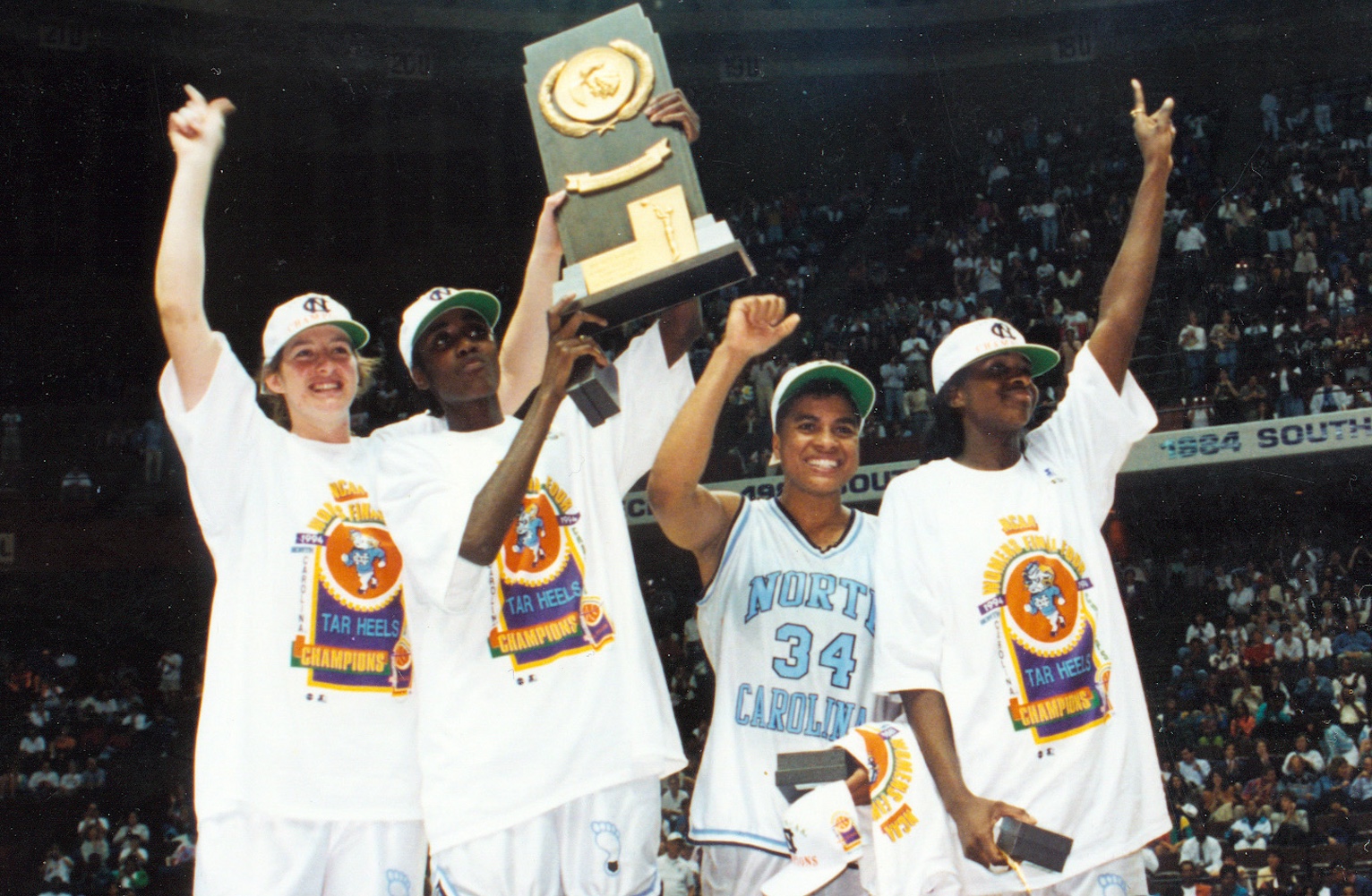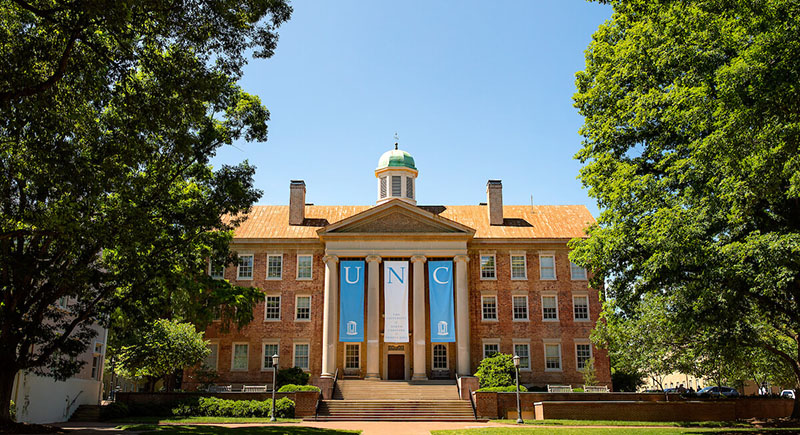
Charlotte Smith and teammates celebrate the 1994 NCAA title. (Photo courtesy UNC Athletics)
UNC athletic teams have won 50 NCAA and 295 ACC championships. The Carolina Champions series asks Tar Heels to share memories from title-winning seasons.
When thinking of some of the biggest shots in Carolina Basketball history, there are any number of valid choices. There’s Michael Jordan’s jump shot to defeat Georgetown in 1982 for the National Title, or Walter Davis’ 35-footer to complete the iconic “8 points in 17 seconds” against Duke in 1974. More recently, Marcus Paige, Luke Maye and Caleb Love have added their names to Carolina lore with iconic baskets of their own. However, the biggest basketball shots in Carolina history are in no way exclusive to the men’s program.
The year was 1994; the venue was the historic Richmond Coliseum; and the opponent was Louisiana Tech, competing against the Tar Heels for the NCAA Women’s Basketball National Championship that season. In a game where neither team could gain a true edge, it came down to the final 0.7 seconds to decide a winner. That’s when junior forward Charlotte Smith ’95 was able to shake a defender on the baseline inbounds pass and swish a three-point jumper from the right side that would give the Tar Heels their first and only national championship.
For the team and Smith, whose 20 points and 23 rebounds in the championship game earned her Final Four Most Outstanding Player honors, that national title capped off a season of hard work and dedication. The Tar Heels finished with an overall record of 33-2 and were ACC Tournament Champions for the first time since 1984.
Smith would go on to have a 10-year professional playing career in the United States and Europe, while also beginning her career as an assistant coach for Carolina Women’s Basketball from 2002-2011.
Since 2011, Smith has been the head coach of Elon’s women’s basketball program. She recently took a few minutes, 30 years following her iconic shot, to recount some of her memories of the 1994 campaign.
Q: Can you share a little bit about that season? Some challenges, big moments, anything that of sticks out from the season leading up to the national championship?
Charlotte Smith: I think the biggest thing that sticks out to me is the commitment. It was the commitment to be “all in,” both mentally and physically. We started to take seriously what we put in our bodies in terms of nutrition, the rest. During the preseason, we made a commitment to whatever the coaches asked us to do. We knew we had an opportunity to be successful, because we had been together for three years and had built a solid foundation. The preparation had been done both mentally and physically. I think the greatest piece was the preparation and the commitment, mentally and physically.
Another thing that stood out to me was our academic advisor. Back in that day, you really didn’t have a sports psychologist full-time on staff or all of the resources that they have now. Jan Boxill, who was our academic advisor, I remember her being sort of like the sports psychologist for our team and teaching us the importance of visualization and creating mental success. It manifested in the physical. I just remember doing visualization, where we would lay down on the floor, close our eyes, see ourselves rebounding, see ourselves defending, see ourselves making that shot. I think the mental preparation, the physical preparation and the commitment was what gave us that advantage, the edge.
Q: What are some things you remember specifically from that championship game against Louisiana Tech?
Charlotte Smith: Well, that was a time when it was back-to-back. There was no break in between. That’s a luxury that they have right now. I wish we would have had that luxury. I just think about the fatigue factor of having a play back-to-back. I remember in the game there were times when I really wanted to put my hand up and check myself out because I was so exhausted just trying to break through those mental hurdles to push through the play, a 40-minute game back-to-back.
It was Easter Sunday. I remember going to Cracker Barrel for breakfast. This is a weird story that a lot of people don’t know. They had little bottles of hot sauce at the table. I thought, “I’m going to take these little bottles of hot sauce for preparation for the game.” I remember a lot of our families being around because we had a devotional that day with the team and the families. My dad led the devotional. It was from, I think, Corinthians, where it talks about one body, many members. Talking about how we were one team and how we all had these different talents, gifts and abilities that we needed to be successful to win a national championship. One body, many members, and just buying into being one body.
I remember being in the locker room before the game and just trying to be loose and trying to not allow people to be uptight. That’s when the bottles of hot sauce come into play. Everybody has their own different method of preparation. Some people joined in the likes of Marion Jones and Tanya Cooper and Jill Suddreth. I was telling them, “Let’s take a shot of hot sauce so we can get fired up.” That was my way of just staying loose and not letting the magnitude of the moment make me be uptight for the game. We took a couple shots of hot sauce and were kind of loose and playing around in the locker room.
And then, what I remember about the game is it just being nip and tuck, just back and forth, and never being able to pull away. There was no breathing room. That was mentally exhausting. Trying to create a gap in the point spread, and it just never was there. Just trying to figure a way mentally how to deal with the pressure of not being able to pull away. I remember Marion Jones getting in foul trouble early and having to go to the bench.
Q: Take us through the final moments of that game that you’ve probably relived thousands of times in the past 30 years.
Charlotte Smith: I remember being in a zone defense, and there was a little breakdown in communication [Louisiana Tech’s]. Pam Johnson comes down, and she hits a baseline, about 15-foot, jumper. That puts them up by two, and that kind of took the wind out of my sail, because I’m like, “Oh gosh, we’re down.” I think I inbounded it really slow because I was stunned that she hit that shot.
We go down the length of the court. We don’t call a time out. We launched up a shot and it hits the backboard. Marion Jones and myself were on the floor scrambling for the loose ball. When the whistle was blown, I remember vividly looking up at the shot clock. I wasn’t a point guard, but I had a point guard mentality because I’m thinking, “How much time do we have left on the clock?” I look up in this 0.7 second, and my heart sinks because I’m thinking there’s no way we can do anything with 0.7 seconds on the clock.
I start thinking about all the hard work that we put in, and we’re here at this moment, it is over. And so Coach Hatchell was trying to inject positivity, uplift us. She draws up a play for a lob. Louisiana Tech had that play scouted to perfection. Coach Hatchell said, “If you can’t get it in, call a timeout.” And this is for all the marbles, we’re going for the win and not the tie.
I was in the huddle thinking, “Well, if we’re going for the win, I’m sure it’s not going to be me, because I wasn’t the best three-point shooter on the team.” Then Coach Hatchell “calls my number.” I remember feeling my heart sink to my feet, because that’s a lot of pressure. It’s one thing to be going for a tie. And then another thing to be going for the win.
I’m thinking, “Gosh, what if I miss? Everybody’s going to hate me.” That was my inner dialogue at that moment. My inner dialogue was just going bananas. It was out of control. It was spiraling downhill so much to the point that when we walked out of the huddle, I didn’t even remember the play. And thankfully I swallowed my pride and was like, “Sylvia Crawley, what play are we running?” She reminded me of the play.
As I was walking, I remember having an inner dialogue, a conversation with God about the magnitude of that moment. When we inbound it, nobody was probably imagining that we were going for the win.
I had a freshman guarding me on the play. They just didn’t communicate.They all probably assumed that the ball was going to Tanya Sampson, because three people went with her. And then I backpedalled out behind the three-point line all by myself. It seemed like an eternity for that ball to get there. The rest is history. We hit the shot, and next comes the pile of people. I’m just on the bottom, just thanking God and just grateful. Wow. The magnitude of that moment and thinking about everything that we put in for the last three years. Going from the worst bottom of the barrel in the ACC, from worst to first in the ACC, and then onto national champions.
Q: The women’s basketball program just celebrated the 30th anniversary of the national championship. Looking back, what does that championship mean to you, 30 years later?
Charlotte Smith: It really is all about the sisterhood. You think about the rings, the trophies, but the greatest championship and the biggest trophy are the relationships that you build. Three of my teammates, Sylvia Crawley; Connie Jackson who was my roommate; and Tanya Cooper; we literally talk to each other and leave video messages every day on a video app, offering encouragement, supporting each other, because rings can’t talk, trophies can’t support you, but teammates can. At the end of the day, it all goes down to that sisterhood that you create for lifelong meaningful relationships.
As told to Andrew Stilwell ’12. Support for UNC Athletics programs helps propel excellence on the field and beyond. Learn more.
Related Stories


